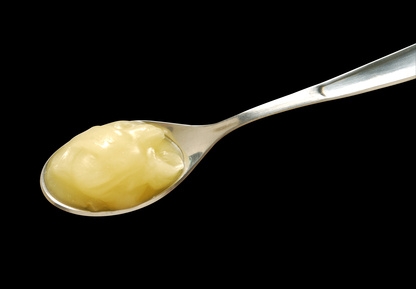Nutrition is a fledgling science and what proves it more then anything else is the fat saga we have been subjected to in the last few decades. We have been given diametrically opposing dietary recommendations by doctors and government health authorities alike and although there now seems to be growing consensus among scientists and researchers on some irrefutable fat facts, there still is a lot of confusion among the general public about the kinds of fat to eat and the effects those fats have on our health, our heart health most importantly. The biggest misunderstandings seem to be with regards to saturated fats as well as poly-unsaturated fats. In this article I will outline some basic fat facts that will hopefully clear up some of the confusion.
The 5 kinds of fats we find in our diets
1. Long Chain Saturated Fat
These are the fats that are found mostly in dairy and the meat of ruminant animals (cattle and sheep). Butter, ghee, lard are some of the long chain saturated fats used for cooking. Traditionally these fats were used freely in our diets until the 1950s when, on the basis of what has now been recognized as incomplete research data, the world began to mistakenly pinpoint these same fats as the underlying cause of heart disease.
In 1953 Dr. Ancel Keys published a paper on the link between saturated fats and heart disease. The report was based on an underlying study of 6 countries that linked a high consumption of fat to a high rate of heart disease. It was this paper that started the global demonization of saturated fats.
What we now know is that Dr. Keys conveniently left data of 16 other countries out of his study which, had they been included, would have proven the exact opposite: countries with the highest rate of saturated fat consumption have the lowest rate of heart disease.
A number of additional scientific studies have since debunked the “myth” that saturated fats are not good for us. In 2010 the results of a meta-analysis were published in the American Journal of Clinical Nutrition, concluding there is no link between the intake of saturated fats and the incidence of heart disease or stroke. * Furthermore, there are several indigenous tribes around the world that are living proof of how eating a high saturated fat diet is possible without heart disease. For example, the people of the Maasai tribe in Kenya and Tanzania thrive on a diet containing 66% saturated fats, the Inuit Eskimos in the Artic on a diet comprising 75% saturated fats. Neither of these tribes have any history of experiencing cardiovascular health problems.
Long chain saturated fats form the core structural fats in our bodies. When the body stores excess energy from food for future use, it stores it primarily as long chain saturated fat. People who are metabolically healthy and have normal insulin levels can eat saturated fats without adverse consequences. Even in high doses these fats are non-toxic and can easily be burned for energy.
Saturated fats have been scientifically proven to enhance the immune system, build strong bones (helps absorb calcium), provide energy and structural integrity to the cells, protect the liver from alcohol and other toxins, help build healthy lungs (saturated fatty acids create the surfactant that protect and coat the lungs airspaces), provide building blocks for hormones, a healthy brain and nervous system and assist in mineral absorption and cardiovascular health.
One important thing to note: some people with familial hypercholesterolemia are “hyper responders” to saturated fat: it drives up their LDL particle numbers. You can read more on LDL particle numbers (not the same as LDL cholesterol) within the context of cholesterol and heart disease risk here. For those people it may be necessary to reduce the intake of saturated fats and emphasize monounsaturated fats instead.
Verdict: Good for you!
2. Medium Chain Triglycerides
These are another type of saturated fat found in coconut and mother’s milk. They are metabolized differently and, as a result, are very easy to digest. Medium chain triglycerides are burned directly by the liver for energy thereby boosting your metabolism. These fats also contain lauric acid which has anti-viral, anti-bacterial and antioxidant properties.
In addition to these health benefits, coconut oil can withstand the high heat of cooking without becoming unstable or vulnerable to oxidative damage (unlike industrial refined vegetable oils).
Verdict: Good for you!
3. Mono-Unsaturated Fat
These are fats found in beef, avocados, olive oil, and certain nuts (e.g. macadamias). Just like long chain saturated fats, they form core structural fats in the body and they are non-toxic even at high doses. Because these fats are unsaturated they are not as stable and unable to withstand high heat.
Avocados and nuts also contain omega 6 poly unsaturated fats which we need to be careful with, as I will explain later on.
Verdict: Good for you, only don’t over-eat nuts and avocados and use olive oil for lighter cooking.
4. Poly-Unsaturated Fats: omega 6 and 3
These unsaturated fats are essential fatty acids because they are not made by our bodies and have to be obtained through our diet. There are however several problems associated with these fats, especially the omega 6s. First of all, due to their chemical structure these fats are extremely fragile. They are vulnerable to oxidative damage when exposed to light and heat. Secondly, for optimal health we should consume an omega 6 to omega 3 ratio of 1:1 and these fats should account for no more then 4% of our total calories.
The current ratio of omega 6 to omega 3 in our diets has been estimated to be more in the region of 12:1 and higher. Furthermore, because vegetable oils have replaced the more traditional cooking oils and because of an increase in the consumption of refined, processed packaged foods the omega 6 poly-unsaturated fats constitute a lot more then 4% of our total caloric intake. According to research this is what has played a significant role in the rise of modern diseases such as cardiovascular disease, type 2 diabetes, obesity, metabolic syndrome, auto-immune disease etc.
Where do we find these poly-unsaturated fats?
Omega 6:
In small amounts these fats are found in most whole foods: fruits, vegetables, cereal grains and meat. Large amounts are found in industrial processed vegetable oils. Most nuts as well as poultry, especially dark meat with skin contain relatively high amounts as well.
Omega 3:
There are two types of omega 3 fatty acids: short-chain (ALA) and long-chain (EPA and DHA). The long-chain omega 3 is what is beneficial to our bodies. These are found mostly in seafood. The short-chain fatty acids (ALA) are found in plant foods such as flax seeds and walnuts. Our bodies can convert ALA to the long-chain omega 3 fatty acids we need, only the process of doing so is highly inefficient, especially in people who are ill or have nutrient deficiencies.
Verdict: Drastically reduce your omega 6 intake and increase the omega 3s in your diet to re-balance the omega 6 : omega 3 ratio. Consume only in small amounts.
5. Trans Fats
Trans fats are found in their natural form in small amounts in the meat, dairy and fat of ruminant animals. Artificial trans fats are used in certain processed, packaged foods. Most people are well aware of the harmful effects artificial trans fats have on our health. Their use is not as widespread as it used to be and most government health authorities, including India, have labeling laws in place that require companies to report trans fat as an ingredient on product labels. However, as per the current labeling laws there is no requirement to mention small amounts of trans fats on packaged food labels.
Verdict: Not good for you! Eliminate all artificial trans fats in your diet.
Conclusion:
- Long Chain Saturated Fats, Medium Chain Triglycerides and Mono Unsaturated Fats should form the bulk of your fat intake.
- Cook with ghee, coconut oil, palm oil or olive oil.
- Eat small amounts of nuts every day (for reference: a portion size that fits into the palm of your closed hand)
- Use cold pressed olive oil on your salad dressings or just drizzle over raw or cooked veggies.
- Reduce your omega 6 intake: Replace industrial processed vegetable oils with the cooking fats mentioned above. Avoid deep fried foods and processed foods such as chips, biscuits and other snacks fried in vegetable oils.
- Increase your omega 3 intake: Eat fatty fish regularly (3 times a week) or take an omega 3 supplement daily.
- If you must eat processed foods, read the labels. If it mentions Trans fat (“partly hydrogenated vegetable oil”), don’t eat it. Best is to avoid processed food altogether.
It is important to note that when it comes to nutrition, bio-individuality is extremely important. These conclusions are general guidelines but when it comes to a personalised nutrition approach many different factors need to be kept in consideration. These factors include health status, environmental influences, health goals, genetics, activity level, underlying imbalances and more.
If you like to learn more about optimising your diet and lifestyle to suit your individual needs, you can set up a free Discovery Session with me here.
Be well.
Monique


